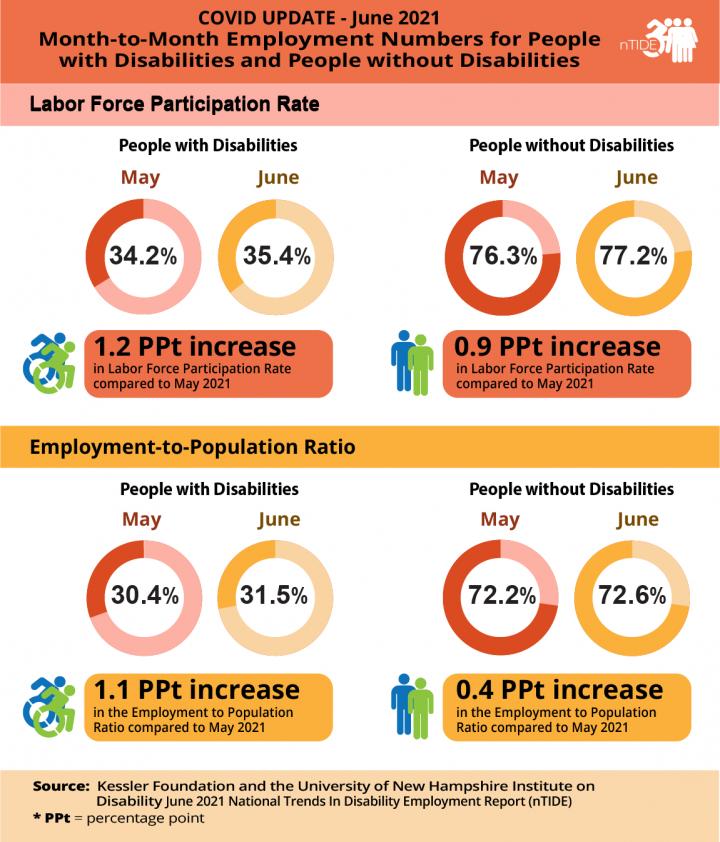National Trends in Disability Employment (nTIDE) — issued semi-monthly by Kessler Foundation and the University of New Hampshire

Credit: Kessler Foundation
East Hanover, NJ – July 2, 2021 – Sharp rises in the job numbers signal economic recovery for people with and without disabilities, according to today’s National Trends in Disability Employment – Monthly Update (nTIDE), issued by Kessler Foundation and the University of New Hampshire’s Institute on Disability (UNH-IOD). Key indicators are closing in on pre-pandemic levels as people with disabilities strengthen their position in the labor market.
nTIDE COVID Update (month-to-month comparison)
In the Bureau of Labor Statistics (BLS) Jobs Report released Friday, the employment-to-population ratio for working-age people with disabilities increased from 30.4 percent in May to 31.5 percent in June 2021 (up 3.6 percent or 1.1 percentage points). For working-age people without disabilities, the employment-to-population ratio also increased from 72.2 percent in May to 72.6 percent in June 2021 (up 0.6 percent or 0.4 percentage points). The employment-to-population ratio, a key indicator, reflects the percentage of people who are working relative to the total population (the number of people working divided by the number of people in the total population multiplied by 100).
“These numbers are very close to pre-pandemic levels. In March 2020, the employment-to-population ratio was 31.7 percent. Today, we are just 0.2 percentage points away,” said economist Andrew Houtenville, PhD, research director of the University of New Hampshire’s Institute on Disability. “Hopefully, this level of employment will be maintained or, even better, exceeded in the coming months and years.” he added.
The labor force participation rate for working-age people with disabilities increased from 34.2 percent in May to 35.4 percent in June 2021 (up 3.5 percent or 1.2 percentage points). For working-age people without disabilities, the labor force participation rate also increased from 76.3 percent in May to 77.2 percent in June 2021 (up 1.2 percent or 0.9 percentage points). The labor force participation rate is the percentage of the population that is working, not working and on temporary layoff, or not working and actively looking for work.
“The labor force participation of people with disabilities is now higher than it was prior to the pandemic. This has been a bright spot during the Covid-19 pandemic, as people with disabilities, perhaps out of economic necessity, remained engaged in the labor market,” said John O’Neill, PhD, director of the Center for Employment and Disability Research at Kessler Foundation. “The last time we saw labor force participation at this level was July 2009,” he emphasized.
Year-to-Year nTIDE Numbers (comparison to the same time last year)
The employment-to-population ratio for working-age people with disabilities increased from 28.4 percent in June 2020 to 31.5 percent in June 2021 (up 10.9 percent or 3.1 percentage points). For working-age people without disabilities, the employment-to-population ratio also increased from 67.7 percent in June 2020 to 72.6 percent in June 2021 (up 7.2 percent or 4.9 percentage points).
The labor force participation rate for working-age people with disabilities increased from 34.4 percent in June 2020 to 35.4 percent in June 2021 (up 2.9 percent or 1 percentage points). For working-age people without disabilities, the labor force participation rate also increased from 76.2 percent in June 2020 to 77.2 percent in June 2021 (up 1.3 percent or 1 percentage points).
In June 2021, among workers ages 16-64, the 5,046,000 workers with disabilities represented 3.5 percent of the total 142,462,000 workers in the U.S.
###
Ask Questions about Disability and Employment
Each nTIDE release is followed by a live #nTIDE Lunch & Learn webinar at 12:00 pm Eastern. hosted via Zoom. featuring Q&A on the latest nTIDE findings, news and updates from the field, as well as invited panelists to discuss current disability-related findings and events. On July 2, Clark Rachfal, director of Advocacy and Governmental Affairs at the American Council for the Blind, joins Dr. Houtenville and Denise Rozell, policy strategist at AUCD. Join live or watch the recordings at: ResearchonDisability.org/nTIDE.
nTIDE COVID Update – Friday, July 23 at 12:00 pm Eastern
Stay tuned for our mid-month update about the employment of people with disabilities as we follow the impact of COVID-19 and look at the numbers in more detail.
NOTE: The statistics in the nTIDE are based on Bureau of Labor Statistics numbers but are not identical. They are customized by UNH to combine the statistics for men and women of working age (16 to 64). nTIDE is funded, in part, by grants from the National Institute on Disability, Independent Living and Rehabilitation Research (NIDILRR) (90RT5037) and Kessler Foundation.
About Kessler Foundation
Kessler Foundation, a major nonprofit organization in the field of disability, is a global leader in rehabilitation research that seeks to improve cognition, mobility, and long-term outcomes — including employment — for people with neurological disabilities caused by diseases and injuries of the brain and spinal cord. Kessler Foundation leads the nation in funding innovative programs that expand opportunities for employment for people with disabilities. For more information, visit KesslerFoundation.org.
About the Institute on Disability at the University of New Hampshire
The Institute on Disability (IOD) at the University of New Hampshire (UNH) was established in 1987 to provide a coherent university-based focus for the improvement of knowledge, policies, and practices related to the lives of persons with disabilities and their families. For information on the NIDILRR-funded Employment Policy and Measurement Rehabilitation Research and Training Center, visit ResearchOnDisability.org.
For more information, or to interview an expert, contact:
Carolann Murphy, 973.324.8382, [email protected].
Graphics:
Title: nTIDE Month-to-Month Employment Numbers for People with and without Disabilities
Caption: This graphic compares the economic indicators for May 2021 and June 2021, showing sharp increases for people with and without disabilities.
Title: nTIDE Year-to-Year Comparison of Economic Indicators for People with and Without Disabilities
Caption: This graphic compares the economic indicators for June 2020 and June 2021, showing modest increases for people with and without disabilities. The labor force participation rate rose for people without disabilities, but remained unchanged for people with and without disabilities, signaling the beginning of economic recovery.
Media Contact
Carolann Murphy
[email protected]




